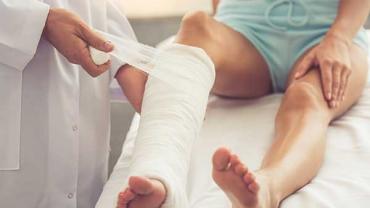
Bone injuries can happen at any time, but they occur more frequently in the summer, when warm weather tempts people to become more active than they typically are during other times of the year. It’s easy for people to take on a bit more than their bodies can handle and hit things hard without a safe and sensible ramping up period. With regard to bone fractures, specifically, the time to think about strengthening bones isn’t in the middle of a summer softball game or a 10K. Bones should be nourished and strengthened all throughout the year so they can easily withstand the greater demands placed on them during more active times.
When we think about bone fractures, what often comes to mind first is the stereotypical image of a frail, elderly woman who’s taken a fall. But brittle bones aren’t just a women’s issue; men are affected by osteoporosis and osteopenia, too. And building bone mass requires far more than just calcium. Bone is built mostly out of protein (collagen, specifically), so ensuring adequate protein intake is crucial for bone health. (It’s a myth that higher protein intakes are bad for bone health.)
Beyond the more obvious calcium and phosphorus, key micronutrients for bone building include boron, magnesium, copper, zinc, manganese, silicon, and vitamin D. There may be an interaction between magnesium status and efficacy of vitamin D supplementation: research indicates that individuals who are magnesium replete require lower doses of vitamin D supplements to achieve optimal vitamin D levels compared to those who are deficient or have lower levels.
Vitamin K2 is another critical nutrient for supporting bone mass. For too long, vitamin K2 lived in the shadow of its better-known relative, the K1 found in leafy green vegetables. Thanks to the resurgence of higher-fat diets and a renewed focus on nose-to-tail eating, K2 has been getting some much deserved time in the limelight. K2 is found predominantly in fatty animal foods, in particular liver, egg yolks, cheese and other dairy foods. (There’s also some in fermented plant foods.) Not all dairy foods are equal when it comes to K2, though. Full-fat dairy has substantially more K2 than reduced fat and fat-free varieties. (No more skim milk and fat-free yogurt, please! These are fine to choose if someone specifically has a need to reduce calorie or fat intake, but there’s no need to avoid dairy fat based on fear of saturated fat. Dairy fat is not only not harmful, but it may be uniquely beneficial in some regards, including for its content of CLA, a naturally occurring trans-fat that may be beneficial for helping to reduce inflammation and facilitating fat loss even independently of diet and exercise.)
Moving beyond nutrients that support the physical architecture of bone tissue, a key strategy for preventing fractures during summer or any other time of year is to build strength and flexibility of bones through weightlifting. Resistance exercise isn’t solely about building muscles; what supports those muscles? What anchors those muscles in place? “Use it or lose it” applies to so many things in the body, including bones.
Aside from specific nutrients and strategies that support bone mass and strength, research suggests that staying metabolically healthy overall might play a role in warding off osteoporosis. There may be a causal link between metabolic syndrome and osteoporosis. This may seem strange at first, but with chronically elevated insulin being the main driver of metabolic syndrome, and elevated insulin affecting much, much more than the comorbidities we typically associate with this condition, it’s not such a stretch of the imagination to imagine that it could also affect bone remodeling.
Patients who neglect their bone health all year can’t expect to hit the trail or the basketball court with strong bones as soon as the weather’s warm and the daylight hours are long. Fortunately, they don’t have to go out of their way to do anything specific just for their bones. Bones respond positively to the same inputs and stimuli the rest of the body responds to: a wholesome, nutrient-rich, lower sugar diet, regular exercise, and intelligent sun exposure.